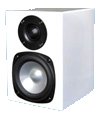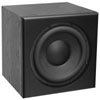Reviews
Kantu
from AUSTRALIAN HI-FI June 1997
According to Dr Rod Crawford, of Legend Acoustics, it's just co-incidence that the name of his company's first speaker sounds just like that of Linn Products' famous Kan II loudspeaker. It is, says this Canberra-based loudspeaker engineer, one of the many words Australian Aboriginals have for the kangaroo, and he intends naming all forthcoming Legend Acoustics models after kangaroos because of the speakers fast, open sound. This would be a very plausible explanation were it not for the fact that Dr Crawford has only recently returned to Australia from Scotland, where he was Senior Acoustic Designer at Linn Products, and responsible for a number of Linn speakers, including the Nexus, Index 2, Helix, Kaber, Keltik and ... Kan II.
However, since Legend Acoustics' Kantu looks nothing like the Linn Kan II, does not use the same drivers, and certainly sounds nothing like a Kan II, I guess the name must be what Dr Crawford claims it is ... a co-incidence.
Technical
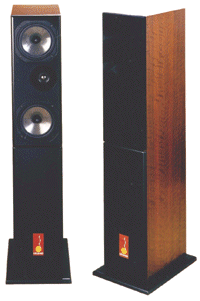 As
you can see from our photograph, the Kantu is a very attractive design.
Its tall, slim-line cabinet is perfectly proportioned, the elegant lines
suggesting a piece of modern sculpture more than a loudspeaker cabinet.
The design of the front baffle, with a D'Appolito array at the top of
the cabinet (perfectly positioning the tweeter at seated ear height) and
the sectioned-off lower half, is turned into a bold statement by the flaming
red, blue and yellow graphic that is Legend Acoustics' logo.
As
you can see from our photograph, the Kantu is a very attractive design.
Its tall, slim-line cabinet is perfectly proportioned, the elegant lines
suggesting a piece of modern sculpture more than a loudspeaker cabinet.
The design of the front baffle, with a D'Appolito array at the top of
the cabinet (perfectly positioning the tweeter at seated ear height) and
the sectioned-off lower half, is turned into a bold statement by the flaming
red, blue and yellow graphic that is Legend Acoustics' logo.
The speakers are so tall (1050 mm), with such a narrow cabinet (200 x 315 mm) that they would be quite unstable were it not for the 258 x 379 mm base plate fitted to the bottom of the loudspeakers. However, even this plate might be a little small if you're positioning the loudspeakers on a soft surface. So, although I would usually suggest the use of spikes primarily for levelling and aiming reasons, in this case I'd suggest using spikes primarily for reasons of stability. Legend provides spikes as standard. However, if you're positioning the Kantus on a solid surface (wood, tile, etc) I'd dispense with the spikes entirely unless your floor surface is uneven, and you need the spikes to prevent speaker wobble.
The rear panel of the Kantus reveals the bass reflex design of the cabinet, in the shape of twin bass reflex ports, each 105 mm long and 47 mm in diameter. Although this size port is sufficient to prevent chuffing, Legend has also curved the edge of each port, to ensure no higher-frequency noises intrude. The panel also shows the elegant, gold-plated input terminals-set up for triwiring.
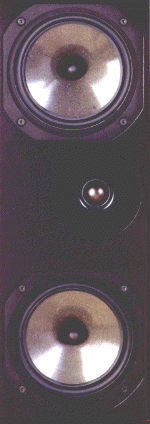
The D'Appolito configuration consists of two 170 mm diameter Aerogel-coned bass/midrange drivers, positioned either side of a 25 mm diameter soft-dome tweeter. The bass drivers (HM17OZO) are made by Audax, in France, and the tweeter by Scanspeak, in Denmark. Audax's aerogel material, for which the company holds a number of patents, uses carbon-fibres to impart stiffness to the cone, to prevent break-up and ensure the cone acts like a piston over its entire operating range. However, to prevent the resonances that can occur in carbon-fibre designs, Audax also incorporates a gel-like material, to provide a measure of damping. Both are applied over a paper base.
The Scanspeak tweeter (D2905) is a standard design, but in the Kantu, it's surrounded by stepped layers of felt, which modify the dispersion characteristics and also ensure there is no possibility of edge reflections.
The loudspeaker grille is, so far as I know, unique. Certainly, I've never seen anything like it in more than twenty years of evaluating loudspeakers. There isn't a grille as such. Instead, there's a small rectangle of black cloth, with strong elastic sewn into the edges. This cloth is stretched over the front baffle, then the elastic is tucked into a deep groove that runs between the baffle and the main part of the speaker cabinet. It's a brilliant idea.
Inside the cabinet I discovered the same attention to detail that's evident outside the cabinet, with heavily cross-braced panels, careful use of hand-applied sealant, and ample damping, some of which was 'eggcrate' foam material (mainly fixed to the cabinet walls) and the rest of which was pure wool. Spread over two boards (both of which are hard wired), the Kantu's crossover network consists of no fewer than eleven high-quality polypropylene capacitors, one air-cored wire inductor, one ironcored wire inductor, and two air-cored hand-wound slit-foil inductors, plus a generous sprinkling of wire-wound resistors. (I wouldn't be surprised if it costs Dr Crawford more to make a single Kantu crossover than it costs KEF to make a pair of Coda 9s). Internal cable is all via heavy-duty multistrand van den Hul cable.
I found the manual to be a model of clarity, and was pleased to see it includes some very sensible advice on loudspeaker positioning, including a short discussion on standing waves. Many people buying loudspeakers fail to appreciate that where they place a pair of loudspeakers in their room has a far greater effect on how they will sound than changing the amplifier or CD player.
Listening Sessions
The rear-firing ports fitted to the Kantus means you can't suffocate them by pressing them right up against a wall but I found the Kantus give optimum performance when they're at least half a metre from a rear wall. And, where the manual states a minimum of 0.5 metres from a side wall, I found that in my room, one metre was the minimum I'd contemplate. It transpired that the bass performance of the Kantus is sufficiently good that, should you wish, you can put the speakers even further out into the room, to improve imaging and depth. However, unless you have a dedicated listening room, such an arrangement usually interferes too much with day-to-day living to be practical.
I listened to the Kantus with the grilles in place, because Legend says performance has been optimised for this configuration. Also, the design of the Audax drivers (they have an exposed voice-coil) seems to suggest using the grilles would be sensible from viewpoint of longevity, as well, since the fine-weave fabric cloth should prevent dirt and dust particles from contaminating the gap between the voice-coil former and the magnet.
I started my listening sessions with the speakers toed-in to aim directly at the listening position. The sound was very good, with a particularly sweet and detailed upper treble performance, but I felt the lower treble sounds were slightly recessed, though I have to confess I could detect this only with solo piano (classical or jazz), and with some string instruments. However, I listen to enough solo piano (particularly when evaluating loudspeakers!) that I decided to play around with positioning, to attempt to correct it. After reading the manual again, I found a sentence I'd missed on a first reading where Legend suggested the speakers should not be toed-in, but 'pointed straight ahead' so I did this. This corrected the slightly recessed sound at my listening position very effectively.
Bass performance was fast and precise, with an immediacy that reminded me of some of the best high-efficiency designs from the US, but with a subtlety reminiscent of some of Robin Marshall's earlier designs. I found this surprising because I was half expecting to hear a 'European' bass, which is slightly brighter and harder than the 'British' bass, yet not quite as brash and forward as a 'US' bass. This is presumably a refinement allowed by the aerogel cone, andI must say that I was impressed. The Kantu digs deep into the bass regions, easily reaching the bottom-most octave (20-40 Hz), though it can't really produce sufficient sound pressure levels below 40 Hz to do the few instruments voiced low enough to occupy this section of the musical spectrum proper justice. Given the small diameter of the drivers used, and the smallish enclosure volume, this is a natural-enough limitation. Dr Crawford has resisted the temptation to put a kick into the region between 40 Hz and 100 Hz, so what you hear is a very flat, accurate sound. Needless to say, there's not the slightest suggestion of boominess-or even a slight flab in bass performance. They seem to be able to absorb prodigious amounts of power, but conversely, can certainly be overdriven if you're careless. Obviously, given the driver configuration, transition to the midrange is seamless - there's no sense of discontinuity, as there is in designs that use different drivers. The actual sound quality across the midrange is very smooth and refined, with a sonic 'roundness' that makes listening a sheer pleasure. High frequencies are wonderful and airy.
By way of example, I found the sound of Dimitri Sgouros' Steinway, recorded live in the Melbourne Concert Hall (MEL 42427-A), was wonderfully real. From the opening notes of Beethoven's 32 Variations in C Minor, it was obvious we were listening to a Steinway and if one had to choose, from the recording, whether one was listening to the acoustic of the Sydney Opera House Concert Hall or the Melbourne Concert Hall, I think those listening via the Kantus would correctly pick the Melbourne venue every time.
Yet another live album (Grace Knight, ABC/EMI 4835832) showed the Kantus ability to reveal an acoustic, in this case that of The Basement, where the curious live/dead echo is apparent from the opening notes of Don Burrows' sax. I found the 'roundness' of the Kantu's midrange softened the Knight's sibilants - perhaps most noticeably on Moondance, with such lines as"whisper and hush ".
Conclusion
Although the Kantu is Legend Acoustics' first loudspeaker, it's not Dr Crawford's first loudspeaker. Even he notes that when you buy a Kantu, you are buying a speaker that was designed "using the knowledge and experience gained when designing a new range of loudspeakers for Scotland's top hi-fi manufacturer. [Excerpt from Kantu Owners' Manual.] The difference is that, for its price, the Kantu uses more expensive drivers and higher-quality crossover components (in a more complex crossover) than would normally be used in an imported loudspeaker. The Kantus are a little sensitive to room positioning, but those who make the effort to position them correctly will find themselves repaid in hifi (and with interest) by the resulting sound quality, first in terms of spectral balance, but also regarding their depth and imaging capabilities. I found them to be very revealing and highly musical loudspeakers.
Greg Borrowman
Test Results
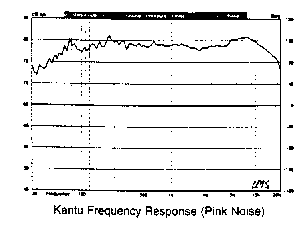
Narrow-band spectrum analysis showed the Kantu's frequency response to be very flat, extending from 50 Hz to 20 kHz ±4 dB, which is an excellent result. Interestingly, the peaks and dips that cause the variance tend to be clustered at points (200 Hz, 900 Hz and 4 kHz) rather than distributed, and the tweeter rolls off quite sharply above 15 kHz. Note, however, that all these 'irregularities' fall within the 4 dB envelope - without them, the response would look more like it issued from a cassette deck than from a loudspeaker! When the response was measured using pink noise as a source (more demanding than the sinusoidal signals used for the spectrum analysis), the Kantus returned an even-better measured result of 45 Hz-15 kHz +- 2 dB.
Steve Holding.




